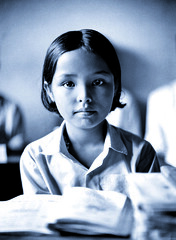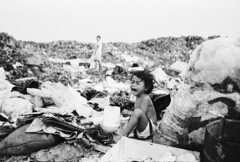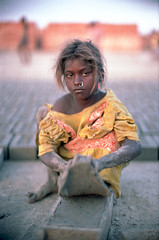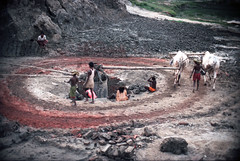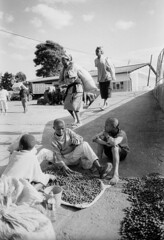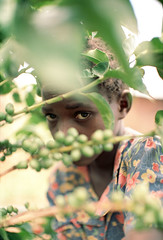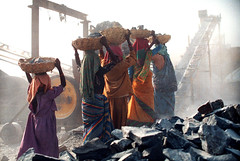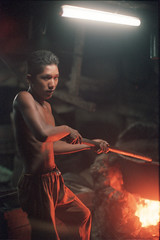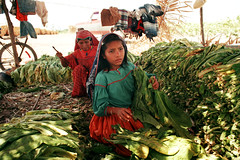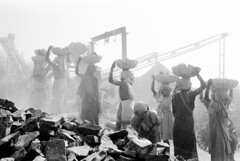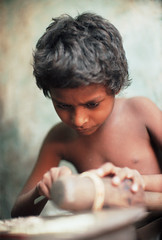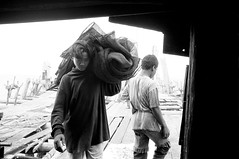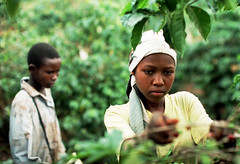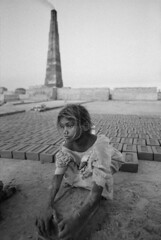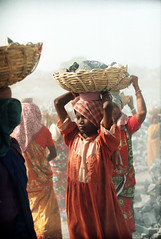Lugares de interés (POIs) del Mapa
0: Laxmi Shresta
Media Voices for Children posted a photo:
At the age of six, Laxmi Shresta helped her mother and two sisters to roll woollen thread in a carpet factory in Nepal. Now Laxmi lives at a RUGMARK rehabilitation center and attends school nearby. RUGMARK pays for her tuition, books, uniforms, food and lodging. Laxmi plans to continue her studies through high school
Más sobre Laxmi Shresta
1: Laxmi Shresta
Media Voices for Children posted a photo:
At the age of six, Laxmi Shresta helped her mother and two sisters to roll woollen thread in a carpet factory in Nepal. Now Laxmi lives at a RUGMARK rehabilitation center and attends school nearby. RUGMARK pays for her tuition, books, uniforms, food and lodging. Laxmi plans to continue her studies through high school
Más sobre Laxmi Shresta
2: Young American Migrant Worker
Media Voices for Children posted a photo:
Young American Migrant Worker
©ROMANO
Eagle Pass, Texas
12-year-old Yesenia prepares to fill another bucket with onions. Forced to leave school early to work in the fields, she is one of an estimated 400,000 to 500,000 children who work in this country to put food on our table. Texas accounts for 60% of the onion seed stock and 25% of the onions consumed in this country.
Más sobre Young American Migrant Worker
3: Young American Migrant Worker
Media Voices for Children posted a photo:
Young American Migrant Worker
©ROMANO
Eagle Pass, Texas
12-year-old Yesenia prepares to fill another bucket with onions. Forced to leave school early to work in the fields, she is one of an estimated 400,000 to 500,000 children who work in this country to put food on our table. Texas accounts for 60% of the onion seed stock and 25% of the onions consumed in this country.
Más sobre Young American Migrant Worker
4: A CRY FOR HELP
Media Voices for Children posted a photo:
A CRY FOR HELP
©ROMANO
BEKASI DUMP
BEKASI, INDONESIA
A toddler screams for her mother who is scavenging at dump for food and things to sell. With unemployment in late 90s reaching 40% in Indonesia, tens of thousands of people were forced to relocate to the countries dumps where they had to scavenge to survive. The Bekasi Dump is the largest in Indonesia and entire families here can expect to earn $70$10 US per week. The children and adults live at the dump in makeshift shelters assembled from scraps of garbage and there is constant danger of getting killed by a bulldozer, falling through the trash and not being able to get out, or being burned by smoldering garbage.
Más sobre A CRY FOR HELP
5: A CRY FOR HELP
Media Voices for Children posted a photo:
A CRY FOR HELP
©ROMANO
BEKASI DUMP
BEKASI, INDONESIA
A toddler screams for her mother who is scavenging at dump for food and things to sell. With unemployment in late 90s reaching 40% in Indonesia, tens of thousands of people were forced to relocate to the countries dumps where they had to scavenge to survive. The Bekasi Dump is the largest in Indonesia and entire families here can expect to earn $70$10 US per week. The children and adults live at the dump in makeshift shelters assembled from scraps of garbage and there is constant danger of getting killed by a bulldozer, falling through the trash and not being able to get out, or being burned by smoldering garbage.
Más sobre A CRY FOR HELP
6: FOUR RESCUED CHILD LABORERS AT SCHOOL
Media Voices for Children posted a photo:
FOUR RESCUED CHILD LABORERS AT SCHOOL
©ROMANO
SAHEP SCHOOL PROGRAM,
SIALKOT, PAKISTAN
Four ex-child laborers take a break from studies at this special school. The program, run by Anita Kawaja, wife of the late sporting goods manufacturer, Anwar Kawaja, helps to keep children out of the workforce and in school where they belong. It is estimated that primary education for all the world’s children would cost 10 billion dollars a year, a drop in the bucket for today’s globalized economy.
Más sobre FOUR RESCUED CHILD LABORERS AT SCHOOL
7: FOUR RESCUED CHILD LABORERS AT SCHOOL
Media Voices for Children posted a photo:
FOUR RESCUED CHILD LABORERS AT SCHOOL
©ROMANO
SAHEP SCHOOL PROGRAM,
SIALKOT, PAKISTAN
Four ex-child laborers take a break from studies at this special school. The program, run by Anita Kawaja, wife of the late sporting goods manufacturer, Anwar Kawaja, helps to keep children out of the workforce and in school where they belong. It is estimated that primary education for all the world’s children would cost 10 billion dollars a year, a drop in the bucket for today’s globalized economy.
Más sobre FOUR RESCUED CHILD LABORERS AT SCHOOL
8: Bonded (Slave) Child Laborer at a Brick Kiln
Media Voices for Children posted a photo:
ROR1299FN04
©Romano
Bonded (Slave) Child Laborer at a Brick Kiln
West Bengal, India
A 9-year-old girl trafficked from a catchment area in neighboring state pulls excess clay from a brick form. The discoloration in her hair is due to vitamin deficiency from a poor diet and long hours of exhausting work in 100 degree plus temperatures. The bricks behind her represent a day’s work. Grinding poverty, race, caste and gender prejudice, bad economic policy, and greedy profit taking all contribute to the terrible plight of the 250 million children that are represented in Stolen Childhoods.
THOUSANDS OF BRICK KILNS LINE LINE THE RIVERBANKS IN BENGAL AND THE SURROUNDING STATES OF INDIA. MOST OF THE WORKERS HERE ARE BONDED (SLAVE) LABORERS. THE FAMILIES THAT WORK HERE ARE EXPLOITED 12-16 HOURS A DAY, 7 DAYS A WEEK. THEIR WORLD CONSISTS ONLY OF THESE MUD HOLES, DRYING FIELDS AND KILNS. AT NIGHT THEY SLEEP IN THE OPEN OR IN MAKESHIFT SHANTYS WHERE SANITARY CONDITIONS ARE NONEXISTENT. THERE ARE NO SCHOOLS HERE, AND FOR MANY OF THE CHILDREN THERE AREN'T EVEN FAMILIES. OVER 1/4 OF THE CHILDREN WORKING HERE HAVE BEEN TRAFFICKED FROM OTHER AREAS WHERE THEIR PARENTS HAVE BEEN FORCED TO EITHER SELL THEM INTO DEBT BONDAGE (SLAVERY) OR, IF THEY ARE LUCKY ENOUGH NOT TO BE BONDED, ARE DEPENDENT ON THE MEAGER WAGES THAT THESE CHILDREN CAN PROVIDE.
THE WORK IS EXTREMELY BRUTAL, HAZARDOUS, ABUSIVE AND SOMETIMES LETHAL. WORKING ALL DAY IN THE HOT SUN WHERE TEMPERATURES REGULARLY CLIMB ABOVE 100F (37C), THEY CARRY WELL OVER A TON OF CLAY A DAY AND CROUCH FOR HOURS AS THEY FABRICATE THOUSANDS OF BRICKS IN OLD FASHION MOLDS. THE PAY, IF THERE IS ANY, AND CONDITIONS FALL WELL BELOW MINIMUM LEVELS REQUIRED BY LAW AND ARE ILLEGAL FOR CHILDREN. NONETHELES THE KIDS COME, DRIVEN BY NECESSITY, OFTEN UNAWARE OF WHAT THEY ARE GETTING INTO AND SOMETIMES TRICKED OR VIRTUALLY KIDNAPPED BY UNSCRUPULOUS AGENTS AND MIDDLEMEN. FOR MANY, THEIR DEBT ACTUALLY INCREASES OVER TIME DUE TO DISHONEST ACCOUNTING.
THE POOR PAY AND HARD WORK ARE JUST THE BEGINNING. BRICK KILN CHILDREN TEND TO BE CHRONICALLY TIRED FROM THE LONG HOURS AND IRREGULAR REST, INCREASING THE PROBABILITY OF ACCIDENTS, INJURIES AND DEFORMITY. DISEASE, MALNUTRITION AND PERMANENT SKELETAL INJURY ARE THE COMMON LOT.
UNABLE TO RECEIVE THE EDUCATION TO WHICH THEY ARE ENTITLED BY LAW, THEY ARE POWERLESS TO ACT, AND TRAPPED IN A CONTINUAL CYCLE OF GRINDING POVERTY.
Bonded Labour, slave labour, CHILD LABOUR TRAVAIL DES ENFANTS Trabajo infantil Kinderarbeit
CHILDREN Kids ENFANTS Niños Kinder
SLAVERY ESCLAVAGE Esclavitud Sklaverei
Más sobre Bonded (Slave) Child Laborer at a Brick Kiln
9: Bonded (Slave) Child Laborer at a Brick Kiln
Media Voices for Children posted a photo:
ROR1299FN04
©Romano
Bonded (Slave) Child Laborer at a Brick Kiln
West Bengal, India
A 9-year-old girl trafficked from a catchment area in neighboring state pulls excess clay from a brick form. The discoloration in her hair is due to vitamin deficiency from a poor diet and long hours of exhausting work in 100 degree plus temperatures. The bricks behind her represent a day’s work. Grinding poverty, race, caste and gender prejudice, bad economic policy, and greedy profit taking all contribute to the terrible plight of the 250 million children that are represented in Stolen Childhoods.
THOUSANDS OF BRICK KILNS LINE LINE THE RIVERBANKS IN BENGAL AND THE SURROUNDING STATES OF INDIA. MOST OF THE WORKERS HERE ARE BONDED (SLAVE) LABORERS. THE FAMILIES THAT WORK HERE ARE EXPLOITED 12-16 HOURS A DAY, 7 DAYS A WEEK. THEIR WORLD CONSISTS ONLY OF THESE MUD HOLES, DRYING FIELDS AND KILNS. AT NIGHT THEY SLEEP IN THE OPEN OR IN MAKESHIFT SHANTYS WHERE SANITARY CONDITIONS ARE NONEXISTENT. THERE ARE NO SCHOOLS HERE, AND FOR MANY OF THE CHILDREN THERE AREN'T EVEN FAMILIES. OVER 1/4 OF THE CHILDREN WORKING HERE HAVE BEEN TRAFFICKED FROM OTHER AREAS WHERE THEIR PARENTS HAVE BEEN FORCED TO EITHER SELL THEM INTO DEBT BONDAGE (SLAVERY) OR, IF THEY ARE LUCKY ENOUGH NOT TO BE BONDED, ARE DEPENDENT ON THE MEAGER WAGES THAT THESE CHILDREN CAN PROVIDE.
THE WORK IS EXTREMELY BRUTAL, HAZARDOUS, ABUSIVE AND SOMETIMES LETHAL. WORKING ALL DAY IN THE HOT SUN WHERE TEMPERATURES REGULARLY CLIMB ABOVE 100F (37C), THEY CARRY WELL OVER A TON OF CLAY A DAY AND CROUCH FOR HOURS AS THEY FABRICATE THOUSANDS OF BRICKS IN OLD FASHION MOLDS. THE PAY, IF THERE IS ANY, AND CONDITIONS FALL WELL BELOW MINIMUM LEVELS REQUIRED BY LAW AND ARE ILLEGAL FOR CHILDREN. NONETHELES THE KIDS COME, DRIVEN BY NECESSITY, OFTEN UNAWARE OF WHAT THEY ARE GETTING INTO AND SOMETIMES TRICKED OR VIRTUALLY KIDNAPPED BY UNSCRUPULOUS AGENTS AND MIDDLEMEN. FOR MANY, THEIR DEBT ACTUALLY INCREASES OVER TIME DUE TO DISHONEST ACCOUNTING.
THE POOR PAY AND HARD WORK ARE JUST THE BEGINNING. BRICK KILN CHILDREN TEND TO BE CHRONICALLY TIRED FROM THE LONG HOURS AND IRREGULAR REST, INCREASING THE PROBABILITY OF ACCIDENTS, INJURIES AND DEFORMITY. DISEASE, MALNUTRITION AND PERMANENT SKELETAL INJURY ARE THE COMMON LOT.
UNABLE TO RECEIVE THE EDUCATION TO WHICH THEY ARE ENTITLED BY LAW, THEY ARE POWERLESS TO ACT, AND TRAPPED IN A CONTINUAL CYCLE OF GRINDING POVERTY.
Bonded Labour, slave labour, CHILD LABOUR TRAVAIL DES ENFANTS Trabajo infantil Kinderarbeit
CHILDREN Kids ENFANTS Niños Kinder
SLAVERY ESCLAVAGE Esclavitud Sklaverei
Más sobre Bonded (Slave) Child Laborer at a Brick Kiln
10: BRICK KILN, WEST BENGAL, INDIA
Media Voices for Children posted a photo:
VIEW OF A MUD CHURN AT A BRICK KILN
©Romano
Mud Churn at a Brick Kiln
West Bengal, India
At dusk, a family still works a mud churn at a brick kiln. The first step in the manufacture of bricks, cattle walk endlessly around a mud hole turning the churn that mixes the mud. Children sit at the edge and pile the mud onto their heads before taking it to the fabricating fields. It is not uncommon for a child to fall into the churn, sometimes mangling their arms or legs. Medical treatment is primitive or non-existent.
THOUSANDS OF BRICK KILNS LINE LINE THE RIVERBANKS IN BENGAL AND THE SURROUNDING STATES OF INDIA. MOST OF THE WORKERS HERE ARE BONDED (SLAVE) LABORERS. THE FAMILIES THAT WORK HERE ARE EXPLOITED 12-16 HOURS A DAY, 7 DAYS A WEEK. THEIR WORLD CONSISTS ONLY OF THESE MUD HOLES, DRYING FIELDS AND KILNS. AT NIGHT THEY SLEEP IN THE OPEN OR IN MAKESHIFT SHANTYS WHERE SANITARY CONDITIONS ARE NONEXISTENT. THERE ARE NO SCHOOLS HERE, AND FOR MANY OF THE CHILDREN THERE AREN'T EVEN FAMILIES. OVER 1/4 OF THE CHILDREN WORKING HAVE BEEN TRAFFICKED HERE FROM OTHER AREAS WHERE THEIR PARENTS HAVE BEEN FORCED TO EITHER SELL THEM INTO DEBT BONDAGE (SLAVERY) OR, IF THEY ARE LUCKY ENOUGH NOT TO BE BONDED, ARE DEPENDENT ON THE MEAGER WAGES THAT THESE CHILDREN CAN PROVIDE.
THE WORK IS EXTREMELY BRUTAL, HAZARDOUS, ABUSIVE AND SOMETIMES LETHAL. WORKING ALL DAY IN THE HOT SUN WHERE TEMPERATURES REGULARLY CLIMB ABOVE 100F (37C), THEY CARRY WELL OVER A TON OF CLAY A DAY AND CROUCH FOR HOURS AS THEY FABRICATE THOUSANDS OF BRICKS IN OLD FASHION MOLDS. THE PAY, IF THERE IS ANY, AND CONDITIONS FALL WELL BELOW MINIMUM LEVELS REQUIRED BY LAW AND ARE ILLEGAL FOR CHILDREN. NONETHELES THE KIDS COME, DRIVEN BY NECESSITY, OFTEN UNAWARE OF WHAT THEY ARE GETTING INTO AND SOMETIMES TRICKED OR VIRTUALLY KIDNAPPED BY UNSCRUPULOUS AGENTS AND MIDDLEMEN. FOR MANY, THEIR DEBT ACTUALLY INCREASES OVER TIME DUE TO DISHONEST ACCOUNTING.
THE POOR PAY AND HARD WORK ARE JUST THE BEGINNING. BRICK KILN CHILDREN TEND TO BE CHRONICALLY TIRED FROM THE LONG HOURS AND IRREGULAR REST, INCREASING THE PROBABILITY OF ACCIDENTS, INJURIES AND DEFORMITY. DISEASE, MALNUTRITION AND PERMANENT SKELETAL INJURY ARE THE COMMON LOT.
UNABLE TO RECEIVE THE EDUCATION TO WHICH THEY ARE ENTITLED BY LAW, THEY ARE POWERLESS TO ACT, AND TRAPPED IN A CONTINUAL CYCLE OF GRINDING POVERTY.
Bonded Labour, slave labour, CHILD LABOUR TRAVAIL DES ENFANTS Trabajo infantil Kinderarbeit
CHILDREN Kids ENFANTS Niños Kinder
SLAVERY ESCLAVAGE Esclavitud Sklaverei
Más sobre BRICK KILN, WEST BENGAL, INDIA
11: BRICK KILN, WEST BENGAL, INDIA
Media Voices for Children posted a photo:
VIEW OF A MUD CHURN AT A BRICK KILN
©Romano
Mud Churn at a Brick Kiln
West Bengal, India
At dusk, a family still works a mud churn at a brick kiln. The first step in the manufacture of bricks, cattle walk endlessly around a mud hole turning the churn that mixes the mud. Children sit at the edge and pile the mud onto their heads before taking it to the fabricating fields. It is not uncommon for a child to fall into the churn, sometimes mangling their arms or legs. Medical treatment is primitive or non-existent.
THOUSANDS OF BRICK KILNS LINE LINE THE RIVERBANKS IN BENGAL AND THE SURROUNDING STATES OF INDIA. MOST OF THE WORKERS HERE ARE BONDED (SLAVE) LABORERS. THE FAMILIES THAT WORK HERE ARE EXPLOITED 12-16 HOURS A DAY, 7 DAYS A WEEK. THEIR WORLD CONSISTS ONLY OF THESE MUD HOLES, DRYING FIELDS AND KILNS. AT NIGHT THEY SLEEP IN THE OPEN OR IN MAKESHIFT SHANTYS WHERE SANITARY CONDITIONS ARE NONEXISTENT. THERE ARE NO SCHOOLS HERE, AND FOR MANY OF THE CHILDREN THERE AREN'T EVEN FAMILIES. OVER 1/4 OF THE CHILDREN WORKING HAVE BEEN TRAFFICKED HERE FROM OTHER AREAS WHERE THEIR PARENTS HAVE BEEN FORCED TO EITHER SELL THEM INTO DEBT BONDAGE (SLAVERY) OR, IF THEY ARE LUCKY ENOUGH NOT TO BE BONDED, ARE DEPENDENT ON THE MEAGER WAGES THAT THESE CHILDREN CAN PROVIDE.
THE WORK IS EXTREMELY BRUTAL, HAZARDOUS, ABUSIVE AND SOMETIMES LETHAL. WORKING ALL DAY IN THE HOT SUN WHERE TEMPERATURES REGULARLY CLIMB ABOVE 100F (37C), THEY CARRY WELL OVER A TON OF CLAY A DAY AND CROUCH FOR HOURS AS THEY FABRICATE THOUSANDS OF BRICKS IN OLD FASHION MOLDS. THE PAY, IF THERE IS ANY, AND CONDITIONS FALL WELL BELOW MINIMUM LEVELS REQUIRED BY LAW AND ARE ILLEGAL FOR CHILDREN. NONETHELES THE KIDS COME, DRIVEN BY NECESSITY, OFTEN UNAWARE OF WHAT THEY ARE GETTING INTO AND SOMETIMES TRICKED OR VIRTUALLY KIDNAPPED BY UNSCRUPULOUS AGENTS AND MIDDLEMEN. FOR MANY, THEIR DEBT ACTUALLY INCREASES OVER TIME DUE TO DISHONEST ACCOUNTING.
THE POOR PAY AND HARD WORK ARE JUST THE BEGINNING. BRICK KILN CHILDREN TEND TO BE CHRONICALLY TIRED FROM THE LONG HOURS AND IRREGULAR REST, INCREASING THE PROBABILITY OF ACCIDENTS, INJURIES AND DEFORMITY. DISEASE, MALNUTRITION AND PERMANENT SKELETAL INJURY ARE THE COMMON LOT.
UNABLE TO RECEIVE THE EDUCATION TO WHICH THEY ARE ENTITLED BY LAW, THEY ARE POWERLESS TO ACT, AND TRAPPED IN A CONTINUAL CYCLE OF GRINDING POVERTY.
Bonded Labour, slave labour, CHILD LABOUR TRAVAIL DES ENFANTS Trabajo infantil Kinderarbeit
CHILDREN Kids ENFANTS Niños Kinder
SLAVERY ESCLAVAGE Esclavitud Sklaverei
Más sobre BRICK KILN, WEST BENGAL, INDIA
12: COFFEE PLANTATION
Media Voices for Children posted a photo:
CHILDREN PICKING COFFEE
© Robin Romano
The work of picking and sorting coffee is perfectly suited to the small hands of obedient young children. Beginning at dawn and working until nightfall, the children help their parents collect the green beans in order to augment the family's income. On some plantations, women and children make up 70% of the workforce. The plants are covered with pesticides and the children are exposed to cancer, respiratory infections, skin rashes as well as exhaustion, heat stroke and dehydration. When they work, which is whenever the coffee is ready to be picked, they naturally miss school.
Más sobre COFFEE PLANTATION
13: COFFEE PLANTATION
Media Voices for Children posted a photo:
CHILDREN PICKING COFFEE
© Robin Romano
The work of picking and sorting coffee is perfectly suited to the small hands of obedient young children. Beginning at dawn and working until nightfall, the children help their parents collect the green beans in order to augment the family's income. On some plantations, women and children make up 70% of the workforce. The plants are covered with pesticides and the children are exposed to cancer, respiratory infections, skin rashes as well as exhaustion, heat stroke and dehydration. When they work, which is whenever the coffee is ready to be picked, they naturally miss school.
Más sobre COFFEE PLANTATION
14: Young Coffee Plantation Migrant
Media Voices for Children posted a photo:
Young Coffee Plantation Migrant
©ROMANO
Misarara Estate Coffee Plantation
Kiambu, Kenya
A young girl picks coffee rather than going to school. Families dependent on money generated by coffee are pulling their children, particularly girls, out of school. The economies of some of the poorest countries in the world are highly dependent on coffee and Kenya is no exception. Nearly 2 million Kenyan children work in the coffee and tea sectors. HIV-AIDS is also a contributing factor to child labor as more and more children become orphaned and are forced to work, often to support their younger siblings.
Más sobre Young Coffee Plantation Migrant
15: Young Coffee Plantation Migrant
Media Voices for Children posted a photo:
Young Coffee Plantation Migrant
©ROMANO
Misarara Estate Coffee Plantation
Kiambu, Kenya
A young girl picks coffee rather than going to school. Families dependent on money generated by coffee are pulling their children, particularly girls, out of school. The economies of some of the poorest countries in the world are highly dependent on coffee and Kenya is no exception. Nearly 2 million Kenyan children work in the coffee and tea sectors. HIV-AIDS is also a contributing factor to child labor as more and more children become orphaned and are forced to work, often to support their younger siblings.
Más sobre Young Coffee Plantation Migrant
16: TOBACCO CHILDREN
Media Voices for Children posted a photo:
Tobacco Children
Nayarit, Mexico
©ROMANO
A Huichol boy harvests tobacco. Dwarfed by the plants, he is continually exposed to nicotine, polluted water, and pesticides. Many of these pesticides have been outlawed in the United States for being too toxic and are dumped on the Mexican market where unenforced labor laws and poor safety and environmental standards are the rule.
Más sobre TOBACCO CHILDREN
17: TOBACCO CHILDREN
Media Voices for Children posted a photo:
Tobacco Children
Nayarit, Mexico
©ROMANO
A Huichol boy harvests tobacco. Dwarfed by the plants, he is continually exposed to nicotine, polluted water, and pesticides. Many of these pesticides have been outlawed in the United States for being too toxic and are dumped on the Mexican market where unenforced labor laws and poor safety and environmental standards are the rule.
Más sobre TOBACCO CHILDREN
18: Light Bulb Factory
Media Voices for Children posted a photo:
UM008FN11
©Romano
Light Bulb Factory
Bihar, India
A boy pulls light bulbs from a whirling centrifuge where injury is a constant threat. He works12-hours a day in a dimly lit factory. Bihar is one of the poorest regions in India and children who do not find work here are often trafficked or sold into servitude to work in neighboring districts like West Bengal and Orissa where they labor in brick kilns and gravel quarries.
Más sobre Light Bulb Factory
19: Light Bulb Factory
Media Voices for Children posted a photo:
UM008FN11
©Romano
Light Bulb Factory
Bihar, India
A boy pulls light bulbs from a whirling centrifuge where injury is a constant threat. He works12-hours a day in a dimly lit factory. Bihar is one of the poorest regions in India and children who do not find work here are often trafficked or sold into servitude to work in neighboring districts like West Bengal and Orissa where they labor in brick kilns and gravel quarries.
Más sobre Light Bulb Factory
20: Bonded Carpet Girl Shaseen and her Mother
Media Voices for Children posted a photo:
Bonded Carpet Girl Shaseen and her Mother
©Romano
Punjab Province, Pakistan
Shaseen was a bonded carpet girl who was gang raped at gunpoint by her owner and his two brothers. Her sister, Naseem received the same treatment. Despite repeated threats, Shaseen’s mother went to the Bonded Labor Liberation Front for help and both her daughters were eventually rescued.
Más sobre Bonded Carpet Girl Shaseen and her Mother
21: Bonded Carpet Girl Shaseen and her Mother
Media Voices for Children posted a photo:
Bonded Carpet Girl Shaseen and her Mother
©Romano
Punjab Province, Pakistan
Shaseen was a bonded carpet girl who was gang raped at gunpoint by her owner and his two brothers. Her sister, Naseem received the same treatment. Despite repeated threats, Shaseen’s mother went to the Bonded Labor Liberation Front for help and both her daughters were eventually rescued.
Más sobre Bonded Carpet Girl Shaseen and her Mother
22: THE GRAVEL QUARRY
Media Voices for Children posted a photo:
ALL DAY GIRLS FILL AND EMPTY HEAVY BASKETS OF ROCK IN ORISSA, INDIA
ROMANO/Stolen Childhoods
Gravel Quarries are a common sight in Orissa and other states in India. The children that work here are exploited 12-16 hours a day, 7 days a week, 365 days a year. Their world consists only of these piles of rocks, dust and back breaking work. At night many sleep in the open or in makeshift shelters where sanitary conditions are nonexistent. There are no schools here, and for many there is no family. Some of the children working here have been trafficked from other areas where their parents have been forced to either sell themselves or their children into debt bondage (Slavery) or, if they are lucky enough not to be bonded, are dependent on the meager wages that these children can provide.
The work is extremely brutal, hazardous, abusive sometimes lethal. Working all day in the hot sun where temperatures regularly climb above 100F (37C), they carry well over a ton of rock a day, to stand on line exposed to the rock dust from the grinder. The pay, If there is any, is minimal, and conditions fall well below minimum levels required by law and are illegal for children . Nonetheless the kids work, Driven by necessity , often unaware of what they are getting into and sometimes tricked or virtually kidnapped by unscrupulous agents and middlemen. For many, their debt actually increases over time due to dishonest accounting.
The poor pay and hard work are just the beginning. These children tend to be chronically tired from the long hours, increasing the probability of accidents, injuries and deformity. Disease, malnutrition and permanent skeletal injury and silicosis are the common lot. Many die before they reach 30.
Medical treatment is primitive or non-existent
Unable to receive the education to which they are entitled by law, they are powerless to act, and trapped in a continual cycle of grinding poverty.
Más sobre THE GRAVEL QUARRY
23: THE GRAVEL QUARRY
Media Voices for Children posted a photo:
ALL DAY GIRLS FILL AND EMPTY HEAVY BASKETS OF ROCK IN ORISSA, INDIA
ROMANO/Stolen Childhoods
Gravel Quarries are a common sight in Orissa and other states in India. The children that work here are exploited 12-16 hours a day, 7 days a week, 365 days a year. Their world consists only of these piles of rocks, dust and back breaking work. At night many sleep in the open or in makeshift shelters where sanitary conditions are nonexistent. There are no schools here, and for many there is no family. Some of the children working here have been trafficked from other areas where their parents have been forced to either sell themselves or their children into debt bondage (Slavery) or, if they are lucky enough not to be bonded, are dependent on the meager wages that these children can provide.
The work is extremely brutal, hazardous, abusive sometimes lethal. Working all day in the hot sun where temperatures regularly climb above 100F (37C), they carry well over a ton of rock a day, to stand on line exposed to the rock dust from the grinder. The pay, If there is any, is minimal, and conditions fall well below minimum levels required by law and are illegal for children . Nonetheless the kids work, Driven by necessity , often unaware of what they are getting into and sometimes tricked or virtually kidnapped by unscrupulous agents and middlemen. For many, their debt actually increases over time due to dishonest accounting.
The poor pay and hard work are just the beginning. These children tend to be chronically tired from the long hours, increasing the probability of accidents, injuries and deformity. Disease, malnutrition and permanent skeletal injury and silicosis are the common lot. Many die before they reach 30.
Medical treatment is primitive or non-existent
Unable to receive the education to which they are entitled by law, they are powerless to act, and trapped in a continual cycle of grinding poverty.
Más sobre THE GRAVEL QUARRY
24: Boiling Teri
Media Voices for Children posted a photo:
Boiling Teri
Straits of Malacca, Indonesia.
A 15-year-old boils Terri before packing it up for shipment to the coast. He has worked on the Jermals since he was 13. Working endless hours over steaming vats, often the children are scalded and burned. For all their backbreaking work Jermal children make $9 or less a month and almost a third of them are never paid.
Más sobre Boiling Teri
25: Boiling Teri
Media Voices for Children posted a photo:
Boiling Teri
Straits of Malacca, Indonesia.
A 15-year-old boils Terri before packing it up for shipment to the coast. He has worked on the Jermals since he was 13. Working endless hours over steaming vats, often the children are scalded and burned. For all their backbreaking work Jermal children make $9 or less a month and almost a third of them are never paid.
Más sobre Boiling Teri
26: GIRLS STRING TOBACCO
Media Voices for Children posted a photo:
Tobacco Children
Nayarit, Mexico
©ROMANO
A Huichol girl strings tobacco. Indigenous Huicholes families migrate from tiny mountain villages every year to work in the tobacco fields of Nayarit, Mexico. They live out in the open, eking out no more than a subsistence living. They make 50¢ per string of tobacco, a job that includes picking, sorting, drying, and threading.
Más sobre GIRLS STRING TOBACCO
27: GIRLS STRING TOBACCO
Media Voices for Children posted a photo:
Tobacco Children
Nayarit, Mexico
©ROMANO
A Huichol girl strings tobacco. Indigenous Huicholes families migrate from tiny mountain villages every year to work in the tobacco fields of Nayarit, Mexico. They live out in the open, eking out no more than a subsistence living. They make 50¢ per string of tobacco, a job that includes picking, sorting, drying, and threading.
Más sobre GIRLS STRING TOBACCO
28: GRAVEL QUARRY, ORISSA, INDIA
Media Voices for Children posted a photo:
ALL DAY GIRLS FILL AND EMPTY HEAVY BASKETS OF ROCK
Romano/Stolen Childhoods
Gravel Quarries are a common sight in Orissa and other states in India. The children that work here are exploited 12-16 hours a day, 7 days a week, 365 days a year. Their world consists only of these piles of rocks, dust and back breaking work. At night many sleep in the open or in makeshift shelters where sanitary conditions are nonexistent. There are no schools here, and for many there is no family. Some of the children working here have been trafficked from other areas where their parents have been forced to either sell themselves or their children into debt bondage (Slavery) or, if they are lucky enough not to be bonded, are dependent on the meager wages that these children can provide.
The work is extremely brutal, hazardous, abusive sometimes lethal. Working all day in the hot sun where temperatures regularly climb above 100F (37C), they carry well over a ton of rock a day, to stand on line exposed to the rock dust from the grinder. The pay, If there is any, is minimal, and conditions fall well below minimum levels required by law and are illegal for children . Nonetheless the kids work, Driven by necessity , often unaware of what they are getting into and sometimes tricked or virtually kidnapped by unscrupulous agents and middlemen. For many, their debt actually increases over time due to dishonest accounting.
The poor pay and hard work are just the beginning. These children tend to be chronically tired from the long hours, increasing the probability of accidents, injuries and deformity. Disease, malnutrition and permanent skeletal injury and silicosis are the common lot. Many die before they reach 30.
Medical treatment is primitive or non-existent
Unable to receive the education to which they are entitled by law, they are powerless to act, and trapped in a continual cycle of grinding poverty.
Más sobre GRAVEL QUARRY, ORISSA, INDIA
29: GRAVEL QUARRY, ORISSA, INDIA
Media Voices for Children posted a photo:
ALL DAY GIRLS FILL AND EMPTY HEAVY BASKETS OF ROCK
Romano/Stolen Childhoods
Gravel Quarries are a common sight in Orissa and other states in India. The children that work here are exploited 12-16 hours a day, 7 days a week, 365 days a year. Their world consists only of these piles of rocks, dust and back breaking work. At night many sleep in the open or in makeshift shelters where sanitary conditions are nonexistent. There are no schools here, and for many there is no family. Some of the children working here have been trafficked from other areas where their parents have been forced to either sell themselves or their children into debt bondage (Slavery) or, if they are lucky enough not to be bonded, are dependent on the meager wages that these children can provide.
The work is extremely brutal, hazardous, abusive sometimes lethal. Working all day in the hot sun where temperatures regularly climb above 100F (37C), they carry well over a ton of rock a day, to stand on line exposed to the rock dust from the grinder. The pay, If there is any, is minimal, and conditions fall well below minimum levels required by law and are illegal for children . Nonetheless the kids work, Driven by necessity , often unaware of what they are getting into and sometimes tricked or virtually kidnapped by unscrupulous agents and middlemen. For many, their debt actually increases over time due to dishonest accounting.
The poor pay and hard work are just the beginning. These children tend to be chronically tired from the long hours, increasing the probability of accidents, injuries and deformity. Disease, malnutrition and permanent skeletal injury and silicosis are the common lot. Many die before they reach 30.
Medical treatment is primitive or non-existent
Unable to receive the education to which they are entitled by law, they are powerless to act, and trapped in a continual cycle of grinding poverty.
Más sobre GRAVEL QUARRY, ORISSA, INDIA
30: Bangle Making
Media Voices for Children posted a photo:
1298FN21
©Romano
Bangle Making
West Bengal, India
A 7-year-old boy works putting glass ornaments onto bangles sold as far away as the US and EU. Working in cramped conditions and exposed to the constant heat of a small forge at his side, his life is one of constant misery. His chances of ever receiving an education are almost nonexistent due in large part to bureaucratic hurdles, poor access, an incompetently run education system and the lack of official commitment to make education - not work - a priority for children.
Más sobre Bangle Making
31: Bangle Making
Media Voices for Children posted a photo:
1298FN21
©Romano
Bangle Making
West Bengal, India
A 7-year-old boy works putting glass ornaments onto bangles sold as far away as the US and EU. Working in cramped conditions and exposed to the constant heat of a small forge at his side, his life is one of constant misery. His chances of ever receiving an education are almost nonexistent due in large part to bureaucratic hurdles, poor access, an incompetently run education system and the lack of official commitment to make education - not work - a priority for children.
Más sobre Bangle Making
32: JERMAL (FISHING PLATFORM), N.SUMATRA, INDONESIA
Media Voices for Children posted a photo:
Two boys bring in nets for patching on a jermal.
©Romano / Stolen Childhoods
A jermal is a fishing platform perched precariously on long stilts in the shallow seas off north Sumatra. there are between 1,200 and 1,500 such platforms with more than 5,000 kids (ages 10 - 17) at work on them. Their world consists only of these rickety wooden structures not much larger than a tennis court, 15 to 50 km off the coast, sitting a few meters above the waves. Perhaps 10 workers live on each, half or more of whom are children.There is little safety equipment. Living amenities are minimal.
The work is extremely hazardous, abusive and sometimes lethal, as many of the children are unable to swim and either fall off the platforms or are dragged down by and caught in the netting. Work lasts 12, 16 even 20 hours at a stretch, lifting heavy nets filled with teri, a small, anchovy-like fish, sorting the teri from stinging jellyfish or seasnakes, then boiling, salting and drying the catch. Then, after snatching a few hours of sleep, they will work again the next day, and the next, month after month.
The minimum stay is three months, without any time on shore. Those how go home before three months won't get any pay. And the wage is meager for all that backbreaking work. Beginners get $5.00 a month, while an experienced boy may get $10. And since the money is handed over only when a boy is leaving, complaining is
useless. The pay and conditions are far below legal standards, but still the kids come, driven by necessity, often unaware of what they are getting into and sometimes tricked or virtually kidnapped by unscrupulous agents.
Jermal kids tend to be chronically tired from the long an irregular hours, increasing the probability of accidents and injuries. Nutrition is poor. Meals consist almost entirely of fish and rice; vegetables are a
rarity. Medical treat is primitive or non-existent. Isolation breeds emotional problems. There are fights among the children. Worst is the abuse -- emotional, verbal, physical, even sexual -- at the hands of older workers or the foreman. Not every jermal is so hellish, but none are places for a child.
Más sobre JERMAL (FISHING PLATFORM), N.SUMATRA, INDONESIA
33: JERMAL (FISHING PLATFORM), N.SUMATRA, INDONESIA
Media Voices for Children posted a photo:
Two boys bring in nets for patching on a jermal.
©Romano / Stolen Childhoods
A jermal is a fishing platform perched precariously on long stilts in the shallow seas off north Sumatra. there are between 1,200 and 1,500 such platforms with more than 5,000 kids (ages 10 - 17) at work on them. Their world consists only of these rickety wooden structures not much larger than a tennis court, 15 to 50 km off the coast, sitting a few meters above the waves. Perhaps 10 workers live on each, half or more of whom are children.There is little safety equipment. Living amenities are minimal.
The work is extremely hazardous, abusive and sometimes lethal, as many of the children are unable to swim and either fall off the platforms or are dragged down by and caught in the netting. Work lasts 12, 16 even 20 hours at a stretch, lifting heavy nets filled with teri, a small, anchovy-like fish, sorting the teri from stinging jellyfish or seasnakes, then boiling, salting and drying the catch. Then, after snatching a few hours of sleep, they will work again the next day, and the next, month after month.
The minimum stay is three months, without any time on shore. Those how go home before three months won't get any pay. And the wage is meager for all that backbreaking work. Beginners get $5.00 a month, while an experienced boy may get $10. And since the money is handed over only when a boy is leaving, complaining is
useless. The pay and conditions are far below legal standards, but still the kids come, driven by necessity, often unaware of what they are getting into and sometimes tricked or virtually kidnapped by unscrupulous agents.
Jermal kids tend to be chronically tired from the long an irregular hours, increasing the probability of accidents and injuries. Nutrition is poor. Meals consist almost entirely of fish and rice; vegetables are a
rarity. Medical treat is primitive or non-existent. Isolation breeds emotional problems. There are fights among the children. Worst is the abuse -- emotional, verbal, physical, even sexual -- at the hands of older workers or the foreman. Not every jermal is so hellish, but none are places for a child.
Más sobre JERMAL (FISHING PLATFORM), N.SUMATRA, INDONESIA
34: Child Coffee Pickers
Media Voices for Children posted a photo:
Child Coffee Pickers
©ROMANO
Misarara Estate Coffee Plantation
Kiambu, Kenya
Unable to afford school fees, a young girl picks coffee along with her brother. The long hours and exposure to pesticides make her work extremely hazardous. Many children develop open sores and birth defects are a common sight. In Kenya, 30 per cent of the coffee pickers are under fifteen. Migrant laborers and seasonal workers who live in camps and have no clean water or medical facilities are among the most vulnerable participants in the coffee trade and their children more vulnerable still.
Más sobre Child Coffee Pickers
35: Child Coffee Pickers
Media Voices for Children posted a photo:
Child Coffee Pickers
©ROMANO
Misarara Estate Coffee Plantation
Kiambu, Kenya
Unable to afford school fees, a young girl picks coffee along with her brother. The long hours and exposure to pesticides make her work extremely hazardous. Many children develop open sores and birth defects are a common sight. In Kenya, 30 per cent of the coffee pickers are under fifteen. Migrant laborers and seasonal workers who live in camps and have no clean water or medical facilities are among the most vulnerable participants in the coffee trade and their children more vulnerable still.
Más sobre Child Coffee Pickers
36: 9-Year-Old Bonded Child Laborer at a Brick Kiln
Media Voices for Children posted a photo:
9-Year-Old Bonded Child Laborer at a Brick Kiln
©ROMANO
West Bengal, India
A young girl bonded into slavery from a catchment area in a neighboring state pulls excess clay from a brick form. Alone without her family that was forced to sell her, she works day after day, carrying mud and making bricks. The bricks behind her represent a portion of her days work. Caste (social) and gender prejudice make life especially hard for girls in India and around the world.
Más sobre 9-Year-Old Bonded Child Laborer at a Brick Kiln
37: 9-Year-Old Bonded Child Laborer at a Brick Kiln
Media Voices for Children posted a photo:
9-Year-Old Bonded Child Laborer at a Brick Kiln
©ROMANO
West Bengal, India
A young girl bonded into slavery from a catchment area in a neighboring state pulls excess clay from a brick form. Alone without her family that was forced to sell her, she works day after day, carrying mud and making bricks. The bricks behind her represent a portion of her days work. Caste (social) and gender prejudice make life especially hard for girls in India and around the world.
Más sobre 9-Year-Old Bonded Child Laborer at a Brick Kiln
38: 10-Year-Old Child Laborer at a Gravel Quarry
Media Voices for Children posted a photo:
10-Year-Old Child Laborer at a Gravel Quarry
Orissa, India
©ROMANO
A young girl carries a basket filled with 40 pounds of rock on her head. During the course of a day she will carry over a ton of rock in 100 degree plus weather. Exposure to the rock dust from the grinder causes silicosis of the lungs and inevitably leads to respitory illness and sometimes death.
Más sobre 10-Year-Old Child Laborer at a Gravel Quarry
39: 10-Year-Old Child Laborer at a Gravel Quarry
Media Voices for Children posted a photo:
10-Year-Old Child Laborer at a Gravel Quarry
Orissa, India
©ROMANO
A young girl carries a basket filled with 40 pounds of rock on her head. During the course of a day she will carry over a ton of rock in 100 degree plus weather. Exposure to the rock dust from the grinder causes silicosis of the lungs and inevitably leads to respitory illness and sometimes death.
Más sobre 10-Year-Old Child Laborer at a Gravel Quarry
